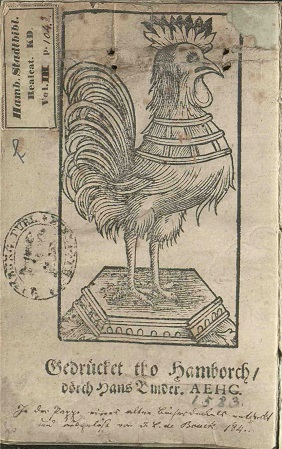Glossary
Rooster primer

Other languages
- Danish: hanebog
- Dutch: haneboek
- Estonian: aabits, kukeaabits
- German: Hahnenfibel
- Latvian: gaiļa ābece
- Norwegian: hane-bog
Material form
Printed bookSubject
Knowledge and skills, Religion and moralityDescription
The label “rooster primer” is used to refer to a reading primer with the image of the rooster on a prominent place of the booklet. Printed since the 1570s in Central Europe and soon after in Northern Europe, in some countries the history of this kind of primers extends into the present. Whereas the position of the picture was originally the last page of the book block (inner book), since the 18th century the rooster is also found on the verso of the title page. From the 19th century onwards, this position varies considerably: the rooster may then also be printed on the title page, the back cover, or the front cover, and in rare cases as a frontispiece.
A rooster primer published in the early modern period is a catechism primer in octavo, primarily for use in Protestant schools, with the image of the rooster produced as a woodcut. In this context the rooster was meant not only as the indication of the day, but also as a religious symbol, especially that of a messenger of divine wisdom. Often this image is accompanied by a verse inciting children to learn. For the period in question three types of the rooster primer can be distinguished: The German-North European type, the Bohemian type, and the Dutch type. The German-North European type is a booklet without a title page and often without a title, normally of 16 pages and printed on thick paper. The first page offers the alphabet in small and capital letters, introduced by an A-initial; in some cases, a book title is offered above the alphabet. The main part of the booklet offers the Chief parts of the catechism, in most cases those of Luther’s Small Catechism, and a series of prayers; the last page shows the picture of a rooster. Primers of this type were printed from the late 16th to the late 19th centuries, with versions in Danish, Estonian (North-Estonian and South-Estonian), Finnish, German (Low German and High German), Latin, Latvian, Lithuanian, Norwegian, Polish, and Swedish. In contrast to this first type, Bohemian type rooster primers encompass 32 pages, including a title page, and the image of a rooster again placed on the last page. They were printed in the 17th and 18th centuries in Bohemia and Moravia, with versions in Czech and German. Finally, Dutch type rooster primers are booklets of 16 pages, including a title page, and the picture of the rooster is usually presented on the verso of this page. Primers of this type were published in the 18th and 19th centuries in Dutch, most of them with catechetical texts in the Reformed (Calvinist) tradition.
Related terms
Catechism primer, reading primer
Sources
Benzing, J., ‘Zur Entstehung der Hahnenfibel‘, Philobiblon 3(1) (1959), 6–19.
Kubálek, J. Hendrich, F. Šimek, Naše slabikáře. Od nejstarší doby do konce století XVIII (Praha: Státní nakladatelství, 1929).
Põldvee, Aivar, ‘Meie vanima aabitsakuke genealoogiast’, Koostanud Piret Lotman, Pildikeel kirjakultuuris/ The language of images in literary culture (Tallinn: Eesti Rahvusraamatukogu, 2024), 118-151.
Skjelbred, D., ‘“Naar Hanen glad og munter galer…” Litt om hane-symbolet i norske abc-bøker’, Skolen 1995–96. Årbok for norsk utdanningshistorie, 1995, 12–18.
Sroka, W., ‘Rooster primers: A transnational history from the sixteenth to the twenty-first centuries’, B. Juska-Bacher et al. (eds.): Learning to Read, Learning Religion. Catechism primers in Europe from the sixteenth to the nineteenth centuries. (Amsterdam: John Benjamins, 2023), 319-335.
Stellingwerff, J., Kleine geschiedenis van het Groot ABC-boek of Haneboek (Den Haag: Ministerie van Onderwijs en Wetenschappen, 1979).
Willke, I., ‘Der Hahn in Katechismus-ABC-Büchern und anderen‘. I. Willke, ABC-Bücher in Schweden – ihre Entwicklung bis Ende des 19. Jahrhunderts und ihre Beziehungen zu Deutschland (Stockholm: Bonniers, 1965), 95-112.
Willke, I., ‘Das schwedische ABC-Buch vergangener Jahrhunderte und seine Hähne‘, Internationale Schulbuchforschung 19(3) (1997), 239–248.

